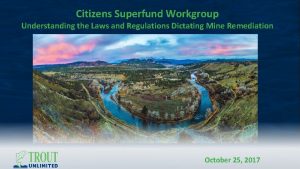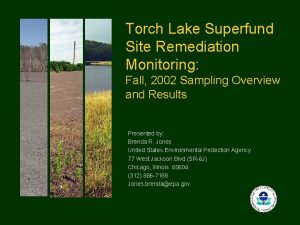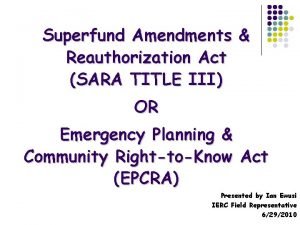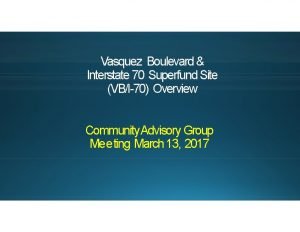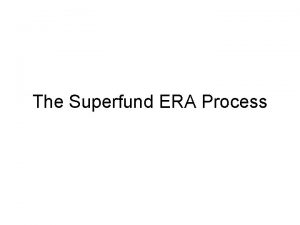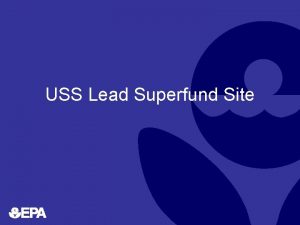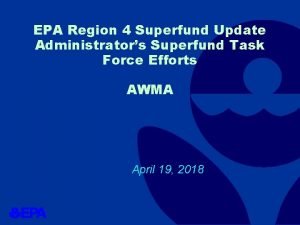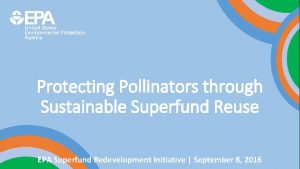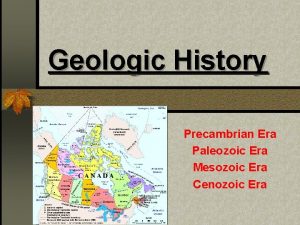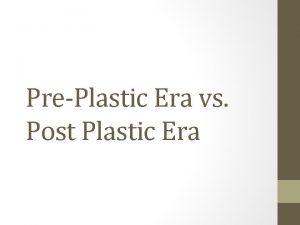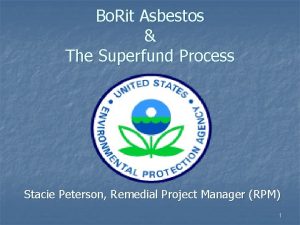The Superfund ERA Process What is Superfund Superfund


















- Slides: 18

The Superfund ERA Process

What is Superfund? • Superfund was created on December 11, 1980 when Congress enacted the Comprehensive Environmental Response, Compensation, and Liability Act (CERCLA). This law created a tax on the chemical and petroleum industries and allowed the Federal government to respond to releases or potential releases of hazardous wastes that might harm people or the environment. The tax went to a Trust Fund for cleaning up abandoned or uncontrolled hazardous waste sites. CERCLA was amended by the Superfund Amendments and Reauthorization Act (SARA) on October 17, 1986. • A Superfund site is any land in the United States that has been contaminated by hazardous waste and identified by the Environmental Protection Agency (EPA) as a candidate for cleanup because it poses a risk to human health and/or the environment.

How does a site become Super? • Once a potentially hazardous waste site is reported to EPA, trained inspectors from EPA, the state, or tribal government perform a preliminary assessment. During this short inspection, EPA tries to determine whether the site presents a hazard to human health and the environment. Often a more detailed review of the site, a site inspection (SI), is required. The SI enables EPA to gather data to score the site according to the Hazard Ranking System (HRS), which in turn determines whether or not the site should be added to the National Priorities List (NPL). • EPA, the state or tribal government will perform a risk assessment at all NPL sites to determine the risk a site poses to human health and the environment. If an unacceptable risk exists, EPA will select a remedy that makes the site safe.

Superfund Sites in our Region 1, 612 Active Sites in US

Aerial View of the Tonolli Metals Superfund site (PA) with stockpiled petroleum contaminated soil on left.

Tar Creek Superfund Site, Picher, OK

Baird & Mc. Guire EPA SUPERFUND SITE * ranked by the EPA as the 14 th worst site in the nation out of over 2, 000 Superfund sites. The Baird & Mc. Guire Superfund Site is located 14 miles south of Boston in the Town of Holbrook, Massachusetts. The site is approximately 20 acres in size. Baird & Mc. Guire, Inc. formerly occupied the site and operated as a chemical mixing and batching company from 1912 until 1983. The facility consisted of a tank farm, mixing and laboratory buildings, a warehouse building, and various storage and disposal structures. Products created on-site included pesticides, herbicides, wood preservatives, fertilizers, disinfectants, soaps, floor wax, and paint. Due to years of improper waste handling and disposal practices of Baird & Mc. Guire, which included direct discharges to the ground, wetlands and surface water bodies, the site began to exhibit unmistakable signs of contamination. Contamination was found at the South Street well field located on-site. The well field served as a public drinking water supply source for the Town of Holbrook for many years and had to be abandoned after contamination was discovered.

Onondaga Lake Bottom Subsite of the Onondaga Lake Superfund Site The selected remedy is estimated to include the dredging of up to 2. 65 million cubic yards of sediment from the portion of the lake in which water depths range from 0 to 30 feet--with most of the dredging being performed in the southwest portion of the lake. It will also include the use of isolation capping over an estimated 425 acres of this area. The estimated cost to implement the remedy is approximately $451 million; the cost to construct the remedy is estimated to be $414 million, and the estimated average annual operation and maintenance cost is $3 million.

Anaconda Smelter Superfund Site, Montana Largest Superfund Site in America

Paducah Gaseous Diffusion Plant, Kentucky






How would you go about determining if there was a risk to human or ecological health at a particular site? • Scoping Assessment • Screening Assessment • Definitive Assessment


 Superfund act
Superfund act Torch lake superfund site
Torch lake superfund site Superfund titles amended
Superfund titles amended Vasquez boulevard and i-70 superfund site
Vasquez boulevard and i-70 superfund site Baroque music quiz
Baroque music quiz Elizabethan and victorian era
Elizabethan and victorian era Creí que era una aventura y en realidad era la vida
Creí que era una aventura y en realidad era la vida Era uma estrela tão alta era uma estrela tão fria
Era uma estrela tão alta era uma estrela tão fria Hát kết hợp bộ gõ cơ thể
Hát kết hợp bộ gõ cơ thể Slidetodoc
Slidetodoc Bổ thể
Bổ thể Tỉ lệ cơ thể trẻ em
Tỉ lệ cơ thể trẻ em Chó sói
Chó sói Chụp phim tư thế worms-breton
Chụp phim tư thế worms-breton Chúa yêu trần thế alleluia
Chúa yêu trần thế alleluia Kể tên các môn thể thao
Kể tên các môn thể thao Thế nào là hệ số cao nhất
Thế nào là hệ số cao nhất Các châu lục và đại dương trên thế giới
Các châu lục và đại dương trên thế giới Công của trọng lực
Công của trọng lực
